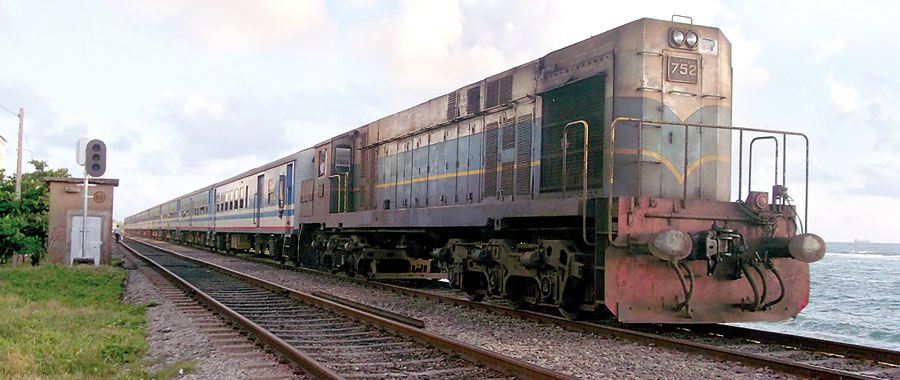The railway’s non-racial model
View(s):Every once in a while, I leave the old jalopy and my trusty rusty steed behind and take to the streets incognito. Dressed in a disreputable T-shirt and jeans that were de rigueur in the 1980s, I step out along the wide and wicked way of the world. Which is to say, towards downtown Colombo. Only a peaked cap tilted at a jaunty angle and cheap shades shelter me from recognition and fame… or so I like to reassure my imagination!

My route takes me (as do rugged loafers, purchased at a seasonal sale at the turn of the millennium) from my urban home to a nearby suburban railway station. Then along the creaking, decrepit line that runs through the backyards of slum and shanty dwellers until it crosses the Baseline Road in search of better prospects. And from one of the central railway termini, I take a train to wherever my fancy leads me. Usually, towards Mount Lavinia and Moratuwa; sometimes Negombo, or Maho, or simply Kandy.
The things some people do for fun? But the double romance of train-spotting while train-travelling brings me an iota closer to the people who comprise my country’s masses. And the often up-close and personal encounters I have with them help me see a brighter, sunnier, more hopeful, and yet more realistic side of Sri Lanka’s common or garden citizenry.
This time, I took the 16.38 from Nugegoda “down” to Colombo Fort. The Kelani Valley line is a study in contrasts. Suburban villas dot the countryside and makeshift tenements abut the railway line. The genteel homes are set well in, cut away from the shrieks of brakes and the grind of weary commuters wending their way home; while sheets of asbestos and tin roofs jut out dangerously in the (surely) unauthorised dwellings so precariously close to the tracks. The track runs between a picturesque golf course’s neatly bifurcated links. Above us, a condominium luxuriates in the dying western sun. Around the glowing scene, stagnant canals refuse to ooze down to a sunless sea.
There are more scenes en route my via Dolorosa that would melt the stoniest heart. A crippled beggar in a dilapidated wheelchair staring listlessly into the shop window of a patisserie, while a family feasts on mouth-watering short-eats (he asked me for Rs. 700 to mend his broken right wheel). The looks of quiet desperation in the eyes of so many commuters burdened by the burgeoning cost of living, as they return home empty-handed until next payday, to spouses and children with eager, upturned faces. This is how some people live. On a mossy embankment, surrounded by the paraphernalia of a vagrant life, a homeless couple sleeps on worn-out ends of corrugated boxes torn up to provide a bed.

A Class M4 MLW Alco Bombardier, No. 752 ("Point Pedro") heads 'Muthu Kumari' - an office-time train that has hauled passengers from points as far apart as Panadura and Puttalam, without once pausing to ask if they were Sinhalese, Tamils, Muslims, Burghers, or any other - an exemplary and ethnically agnostic railway ethic
But now come with me to the more happily populated well-lit beachfront scenes, as a southern express coasts past Kollupitiya and its neighbouring boroughs to its first suburban stop in Ratmalana before conveying its mixed manifest of passengers to darkening towns and already fast-asleep hamlets in the deep south. There are few people who are poor in spirit as the train thunders over bridges and skips nimbly over the few points and crossings on the coastal run. Here all is bright if obviously tired smiles. Helpful hands as the uncertain commuter (late, running) is embraced by fellow occupants of the footboard. Courteous schoolboys after sports practice relinquishing their hard-won seats to elderly gentlemen, pregnant ladies, clergy with inscrutable countenances. In the microcosm of the crowded compartment, all that is good and noble about the average Sri Lankan coalesces, descends on the swaying carriage like some unmerited blessing, and is carried farther afield at fifty miles an hour…
There is purpose, order, direction in the way the lives of people connected to the railways of Sri Lanka go. Daily, weekly, month-in-year-out, setting an example, sowing a lifestyle, reaping a national character. No one is in too much of a hurry. Even late trains eventually arrive, cancelled ones are few and far between. The loneliness of the long-distance traveller is assuaged by the comfort of harmless strangers with whom one can share a newspaper, weather prospects, changes to timetable, the latest political happenings, a brief moment in eternity – without fear of danger, exposure, censure. It is, like all other human institutions, fallen, for sure… pickpockets, perverts, et al. But if there is a time, a space, and an ethic from which to form and shape a new national identity that surpasses race and ethnicity, the racially sterile ethnically anonymous railway culture would be a good place to start. If you get a chance to do so this ‘new year’ season, try riding the rails and perhaps you will see what I mean about the truly national Sri Lankan railway ethos.
Follow @timesonlinelk
comments powered by Disqus















